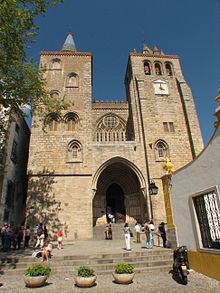Ecclesiastical province Évora Rite Latin Rite Area 13,547 km² Cathedral Cathedral of Évora | Denomination Roman Catholic Pope Francis Country Portugal | |
 | ||
Population
- Total
- Catholics (as of 2006)
290,000
245,900 (84.8%) Established 4th century (As Diocese of Évora)
24 September 1540 (As Archdiocese of Évora) Archbishop José Francisco Sanches Alves | ||
Roman catholic archdiocese of evora
The Roman Catholic Archdiocese of Évora (Latin: Archidioecesis Eborensis) has Évora Cathedral as its see. It has as suffragans the diocese of Beja and diocese of Faro. The current Archbishop of Évora is José Francisco Sanches Alves.
Contents
History
Évora was raised to archiepiscopal rank in 1544, at which time it was given as suffragans the diocese of Leiria and diocese of Portalegre; in 1570 and later were added the diocese of Silves, diocese of Ceuta, diocese of Congo, diocese of São Tomé, diocese of Funchal, diocese of Cabo Verde, and diocese of Angra.
Its bishop, Quintianus, was present at the Synod of Elvira early in the fourth century. There exists no complete list of his successors for the next two centuries, though some are known from ancient diptychs. In 584 the Visigothic king, Liuvigild, incorporated with his state the Kingdom of the Suebi, to which Évora had hitherto belonged. From the sixth and seventh centuries there remain a few Christian inscriptions pertaining to Évora. In one of them has been interpolated the name of a Bishop Julian (1 December, 566); he is, however, inadmissible. Thenceforth the episcopal list is known from the reign of Reccared (586) to the Islamic invasion (714), after which the succession is quite unknown for four centuries and a half, with the exception of the epitaph of a Bishop Daniel (January, 1100).
Until the reconquest (1166) by Afonso I of Portugal, Évora was suffragan to the archdiocese of Mérida. Under this king it became suffragan to the archdiocese of Braga, despite the protests of the Archbishops of Compostella, administrators of Mérida. In 1274, however, the latter succeeded in bringing Évora within their jurisdiction. Finally, it became suffragan to the archdiocese of Lisbon from 1394 to 1544, when it was made an archbishopric.
Among its archbishops were:
Portuguese writers have maintained that the first bishop of Évora was St. Mantius, a Roman, and a disciple of Jesus Christ, sent by the Apostles into the Iberian Peninsula as a missionary of the Gospel.
